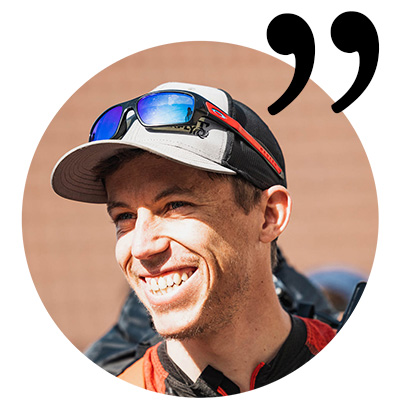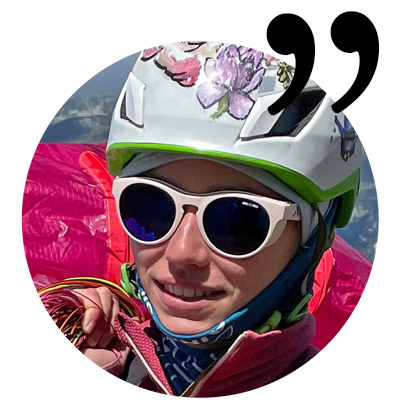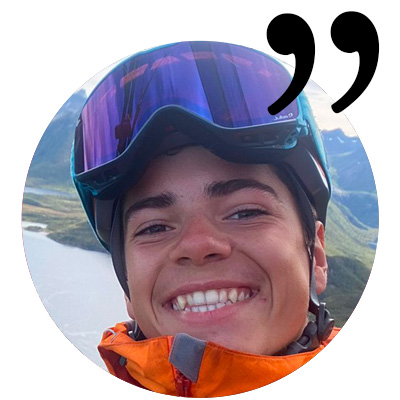True XXS – #sizematters
– Hey Thomas, I don’t understand. When I fly with you, I have no problem staying at cloudbase, not to mention that I’m often the first there. However, when we need to reach the next thermal I’m so slow compared to you! Sometimes I just can’t, especially if there is a little bit of wind. I know my glider is smaller but I’m 50 kg all up and it is certified from 45 kg. What’s the matter with me?
– Classic, Judy. It’s certified from 45 kg but what is the flat area?
– Mmmh let me check… 22 m2 they say.
– What? It’s like if you were flying alone a tandem glider, with your 80 kg all up. How can my glider be certified at 45 kg with such a big surface?
– Certification is one thing, but you have to really take care of the surface loading when looking at your next glider. It is possible to find EN-A or EN-B certified gliders between 18 and 20 m2 flat area, not 22!
– Well, you would benefit from “a normal flying behavior”. You would lift up your glider to take-off more easily, you would core thermals far better (without losing your amazing climbing ability), and last but not least, you would take less risk in windy conditions, not only to be able to move into the wind safely but also during take-off and landing.
Designer’s words…
Stephan Stiegler
Designer
Did you know?
As a pilot and especially a light one, it seems logical to look at the certification weight range to choose wisely your glider. You could be tempted by a “small” glider of 22 m2 because its certification range starts from 45 kg, but 22 m2 is actually a huge surface for a light pilot.
#sizematters
In mid-size gliders, your best friend would always consider flying between the mid and the top of the certified weight range. Now, not only, with your let say 50 kg, you’re at the bottom of the weight range (which your best friend would never accept for him), but you end up with a glider with a very, very low surface loading.
At AirDesign, we work hard on every model to be able to maintain the behavior of the glider in terms of flying, and also outside the flight envelope, for all the certified weights. The certification of most of our wings starts at 50 kg because we chose to announce only what we have actually tested. And above all, because we make sure that the glider is efficient, secure and fun at this load and this is as important as the certification itself! Our aim is to have light pilots find the same pleasure to fly as heavier ones.
AirDesign has a small one
Conclusion: one should not only check the certified weight range when it comes to light pilots. The surface (and so the surface load) is a key information to understand whether a pilot is going to experience the real fun and safety of flying, or whether she/he’s putting her/himself in a “failure” mode potentially going all the way to fear of flying.
Flat or projected?
They know what they’re talking about

When I started hiking and flying, I found myself in the same stalemate with brands that offered very small sizes with nevertheless inaccessible weight range for me without ballast or flying behavior too dangerous to fly serenely. AirDesign then came to me with their new Volt 4 (2 liner) whose small size goes up to 73kg, which corresponds perfectly to my hike-and-fly all up weight. I immediately jumped on this opportunity which allowed me to rediscover the pleasure of flying simply without the constraint of ballast and with the possibility of participating in hike-and-fly competitions with an all-light rucksack.
Very efficient in its category, I was quickly seduced by this glider, which also allowed me to do ski-and f-y combos in winter and many other crazy projects! Before the Volt I was using small, mountain-style wings, but quickly I started to use mainly the Volt. Indeed, the difference in the glider weight is to me not that significant compared to mini wings and the potential for play is so much greater with the Volt that I find less interest in using mini wings. With its minimum all up weight of 60kg, I even use it with Le Slip light harness. The glider behaves well at the bottom of the range. It’s really a rediscovery of paragliding in its simplicity.
Thank you AD for thinking about light pilots 🤩
Rémi B.

After many years where my grandmothers (desperately) tried to fatten me up, in vain, I finally found a solution to enjoy paragliding with the full weight of my 50 kg. Well yes, what’s the point of running to the nearest gram for equipment and improving your cardio without straining if you have to carry some ballast… After 3 years of flying with AirDesign, one thing is certain, whether with the Eazy or the LiVi, I’ve never had to make any concessions to be comfortable under a paraglider and not to have the awkward feeling that I’m driving a truck. Compact gliders (18 m2) and very light to carry, adapted to small weights in their XXS sizes, it’s a real treat. No need for additional ballast to widen your horizon with cross country flights, but also hike-and-fly or volbiv with an unbeatably light backpack!
Agnès G.

Having started to fly very young (13 years old), the choice of my first wing – which was to allow me to start flying on my local hill but also to start some hike-and-fly- included an important parameter: my low weight (- 50 kg ). And I quickly realized that very few brands offered products that really corresponded to what I was looking for, unlike… AirDesign! It was the only brand that offered a school glider, light, in REAL small size: the Eazy! I quickly fell in love with this little wing which allowed me to start and progress, being safe under a glider which was really my size. I have been flying for 3 years now, I now fly the LiVi because AD has always known how to create gliders which coincide with my progress and my low weight!
Jules C. (16 Jahre alt!)

Living close to the Forclaz takeoff above Lake Annecy, I saw so many paragliders go by: flying was obvious to me! At 14, I took my first course and I fell in love with this sport. When I bought my first glider, the drama… I “only” weigh 50 kilos, even during the course, the gliders I flew were a little big for me. I bought one but feeling not very comfortable with my 22m2, I was looking for a brand allowing me despite everything to be serene under my glider, and not to make my weight a problem. I then discovered AirDesign and immediately their motto attracted me, I contacted them and they told me about a wing, the LiVi. Revolution! A glider that I can control and not the other way around! I have the impression of rediscovering the discipline, immediately at ease underneath, I want this LiVi. Regaining confidence in the air , during takeoff, landing… I manage to do new things, to dare more things!! Although my level is still low (only 1 year of flying) I am already doing small cross-country (30 km) and have 250 flights under my belt. Thanks AirDesign for The Onlivy one!
Eloïse A.










